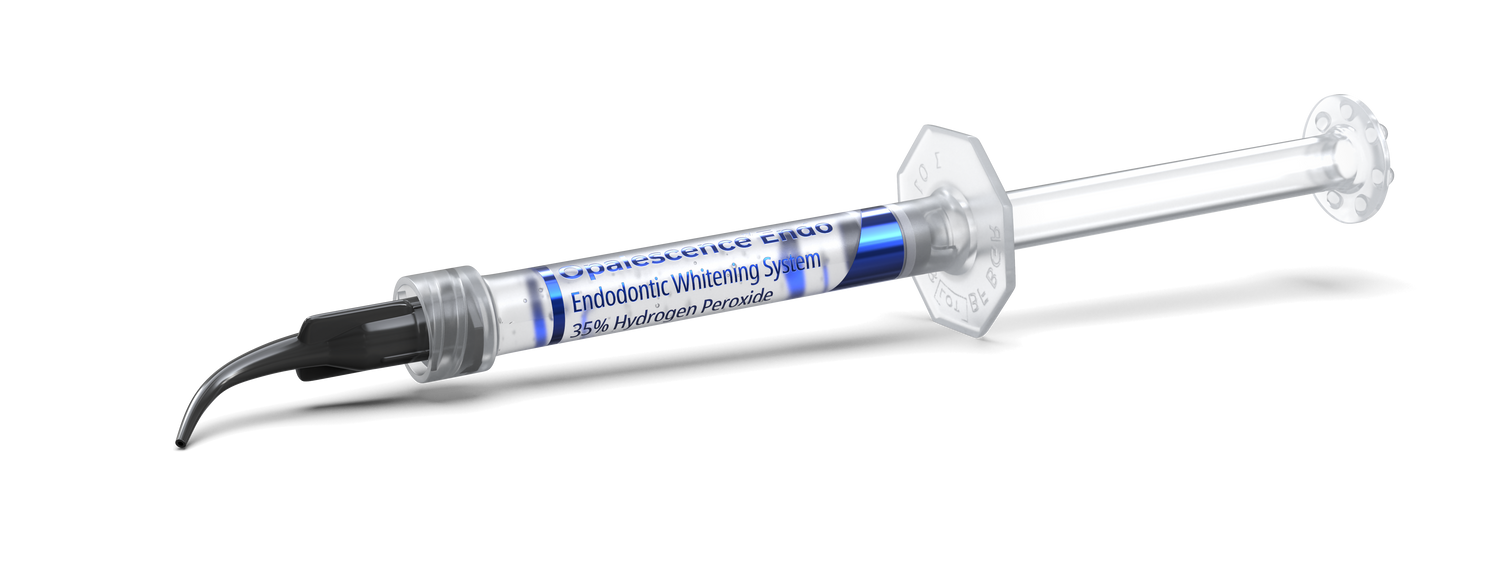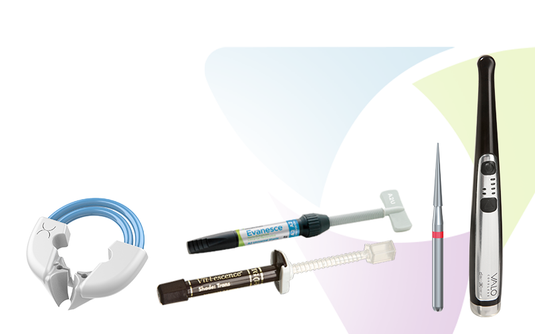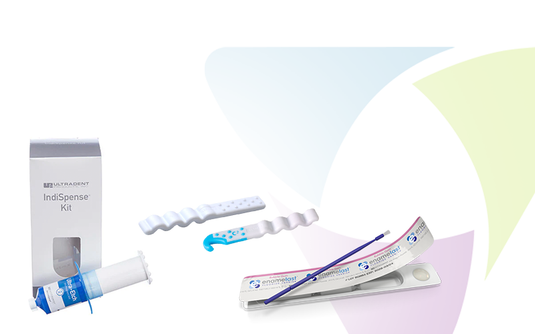
The Walking Bleach Method
Efficient, Uncomplicated and Minimally Invasive Aesthetics for Endodontically Treated Anterior Teeth.
Minimally invasive and aesthetic dentistry is becoming increasingly important — especially in the anterior region. Healthy, white teeth play a key role in self-esteem and social acceptance of patients. Considering this, the discoloration of one or more teeth in the anterior region becomes particularly noticeable and may have a psychological impact on the patient.
Endodontic treatment is primarily dedicated to the preservation of teeth and their function. As a consequence, discoloration or darkening may occur due to numerous reasons which results in an aesthetic impairment. In the anterior region this becomes particularly important, therefore a holistic endodontic approach is the treatment of choice. This includes a state-of-the-art endodontic treatment/retreatment and an adequate restoration under consideration of function and aesthetics. The aesthetics of endodontically treated and discoloured teeth may be restored with veneers or crowns. These indirect restorations, however, require extensive preparations, which in turn result in loss of natural tooth substance. Alternatively, a composite restoration combined with internal tooth whitening — also known as the "walking bleach method”— should be considered. This approach comprises the application of an oxygen-releasing whitening gel directly into the discoloured coronal pulp chamber. An oxidation process is initiated that gradually splits the pigments resulting in a brighter appearance of the tooth substance.
This procedure is illustrated in the case of a 27-year-old female patient. Tooth 21 was non-vital and additionally diagnosed with a chronic apical periodontitis, which has been treated endodontically. As part of the root canal treatment the previously treating dentist had informed the patient about the option of internal tooth whitening. Nevertheless, the patient declined at that time.

Pre-op: Endodontically treated, internal discoloured tooth 21
Being dissatisfied with the aesthetic outcome after all, she presented herself to my practice several months later. Initially, the patient’s expectations were assessed, and the procedure and possibilities of internal tooth whitening
were explained.
In preparation for the walking bleach method, a rubber dam was placed, and the access cavity was re-opened. All restorative and root sealing material was removed from the coronal pulp chamber and 2 - 3 mm below the healthy gingiva (a). The cavity was cleaned thoroughly in order not to compromise the whitening result. After the cleaning procedure, the enamel was etched circumferentially around the access cavity with 37% phosphoric acid in order to provide retention for the temporary fulling (b+c). Next, in order to promote an efficient cervical barrier, the canal obturation and surrounding dentin was etched. A bonding agent Peak™ Universal Bond adhesive was applied following the manufacturer instructions and a 2 mm thick layer of flowable composite was placed (d) and light cured with a VALO™ cordless LED curing light.
Opalescence™ Endo, Ultradent Products, Inc., was applied into the coronal pulp chamber. (e)

Opalescence™ Endo whitening gel was expressed into the coronal pulp chamber, filling the open space up to 2/3 to accommodate the provisional restoration.






Opalescence Endo whitening gel contains 35% hydrogen peroxide and is available in convenient ready-to-use syringes. A suitable Black Mini™ tip or a Micro 20 ga tip, which is attached onto the syringe, allows for a quick and targeted application of the whitening gel. This results in greater accuracy and reduces waste of material making its use very cost-effective. It is important to place a small cotton pellet over the whitening gel to make certain that no whitening agent stays on the margins of the access cavity in order to ensure a good temporary seal (f).
Also, users should leave enough space (1.0 - 1.5 mm) to accommodate the provisional restoration. Finally, the cavity was provisionally sealed with a flowable composite. Following the same protocol, this procedure should be repeated every 1 to 5 days until the desired shade change is achieved or no further benefit is noticed. In the present case, the desired whitening effect was achieved after eight days. The provisional restorative material and the Opalescence Endo whitening gel were removed. After thorough rinsing and cleaning of the access cavity, a new temporary restoration was placed.
As whitening materials may interfere with bonding agents, we observed the result for an additional seven days. This transition period also helped to see whether the tooth needed any further whitening. However, it turned out to be unnecessary as the tooth shade remained stable. Thus, the permanent restoration was created using Peak™ Universal Bond adhesive and Mosaic™ universal composite A2/A3 — following a multi-layering technique. The restoration was finally polymerized with the VALO™ Cordless LED curing light (all products from Ultradent Products, Inc.).
During the two follow-up sessions — the first at seven days and the second after two months — a satisfying result was observed. The patient was extremely happy to be able to laugh again.
In this case internal tooth whitening was better suited than a veneer or a crown while following a minimally invasive approach in order to preserve as much healthy tooth substance as possible.
Opalescence Endo whitening gel is viscous and dimensionally stable, which makes it easy to handle. Additionally, the use of syringes enables a precise and uncomplicated application reducing the required chair time to a minimum.
Opalescence Endo whitening gel is mostly used for anterior teeth — case selection, however, depends on the condition of the tooth in question. If the tooth to be treated was open over a long period or the discoloration is too prominent, crowns or veneers might result in better aesthetics. In an effort to mimic nature, indirect restorations tend to be translucent to various degrees, which might constitute a problem if the prepared tooth is discoloured. Therefore, Opalescence Endo whitening gel may be used to whiten the stump before insertion of the final restorations.
In summary, internal tooth whitening with Opalescence Endo whitening gel is a very simple, painless and cost-effective method to overcome compromised esthetics associated with anterior endodontic treatment.

Before

After
About the Author

Jacques Nicolas Grebowiec, DDS
Dr. Jacques Nicolas Grebowiec has been working in Riga, Latvia since 2015. He is trained in endodontics and microscope-assisted endodontics.
Discover More
This article was originally published in the Clinical Life™ magazine: Winter 2022 edition
Clinical Life™ magazine is a premier periodical publication by Clinical Research Dental Supplies & Services Inc. Discover compelling clinical cases from Canadian and US dental professionals, cutting-edge techniques, product insights, and continuing education events.













